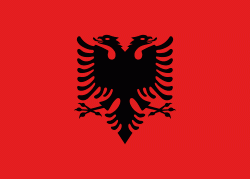Grabovë e Sipërme (Grabova e Sipërme)
Grabovë e Sipërme (also: Grabova; Greãva, Grabuva) is a village in Albania inhabited by Aromanians. The village is located in the former municipality of Lenie. At the 2015 local government reform it became part of the municipality Gramsh.
Grabova was a medieval town created in the 10th century. Aromanians have left Grabova on several occasions, although the village has never been completely deserted. The first wave of depopulation took place in the 17th century, when Grabova shared the fate of Moscopolis and during the inter-war period, starting with 1931, many of Grabovars emigrated to Elbasan and Lushnjë. In 1933, 15 families from the village emigrated to Romania; they initially settled in Southern Dobruja and then, in 1940, in the village of Nisipari, Constanța County, from where they moved to the larger nearby towns (Medgidia, Ovidiu, Constanta). Another important immigration began in 1950, when communist authorities used the craftsmen from Grabova to build the industrial units in Korçë, Pogradec, Gramsh, Elbasan, and Tirana.
In the 18th century the Grabovë Church was built in the village.
Grabova was a medieval town created in the 10th century. Aromanians have left Grabova on several occasions, although the village has never been completely deserted. The first wave of depopulation took place in the 17th century, when Grabova shared the fate of Moscopolis and during the inter-war period, starting with 1931, many of Grabovars emigrated to Elbasan and Lushnjë. In 1933, 15 families from the village emigrated to Romania; they initially settled in Southern Dobruja and then, in 1940, in the village of Nisipari, Constanța County, from where they moved to the larger nearby towns (Medgidia, Ovidiu, Constanta). Another important immigration began in 1950, when communist authorities used the craftsmen from Grabova to build the industrial units in Korçë, Pogradec, Gramsh, Elbasan, and Tirana.
In the 18th century the Grabovë Church was built in the village.
Map - Grabovë e Sipërme (Grabova e Sipërme)
Map
Country - Albania
 |
 |
| Flag of Albania | |
Albania has been inhabited by different civilisations over time, such as the Illyrians, Thracians, Ancient Greeks, Romans, Byzantines, Venetians, and Ottomans. The Albanians established the autonomous Principality of Arbër in the 12th century. The Kingdom of Albania and Principality of Albania formed between the 13th and 14th centuries. Prior to the Ottoman conquest of Albania in the 15th century, the Albanian resistance to Ottoman expansion into Europe led by Skanderbeg won them acclaim over most of Europe. Albania remained under Ottoman rule for nearly five centuries, during which many Albanians (known as Arnauts) attained high-ranking offices in the empire, especially in the Southern Balkans and Egypt. Between the 18th and 19th centuries, cultural developments, widely attributed to Albanians having gathered both spiritual and intellectual strength, conclusively led to the Albanian Renaissance. After the defeat of the Ottomans in the Balkan Wars, the modern nation state of Albania declared independence in 1912. In the 20th century, the Kingdom of Albania was invaded by Italy, which formed Greater Albania before becoming a protectorate of Nazi Germany. Enver Hoxha formed the People's Socialist Republic of Albania after World War II, modeled under the terms of Hoxhaism. The Revolutions of 1991 concluded the fall of communism in Albania and eventually the establishment of the current Republic of Albania.
Currency / Language
| ISO | Currency | Symbol | Significant figures |
|---|---|---|---|
| ALL | Albanian lek | L | 2 |
| ISO | Language |
|---|---|
| SQ | Albanian language |
| EL | Greek language |















